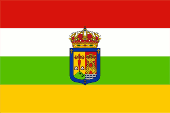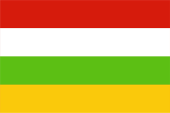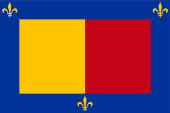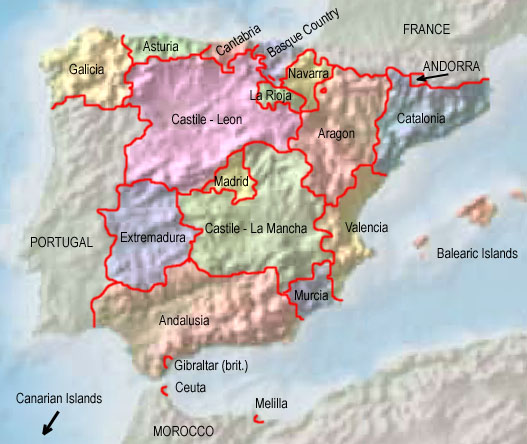La Rioja |
|
|
|
| Übersicht – Contents: | |
Diese Seite ist Teil des Projektes
La Rioja |
|
|
|
| Übersicht – Contents: | |
Flaggen – Flag: |
|
 |
seit/since 1982, |
 |
seit/since 1982, |
| historische und andere Flaggen – historical and other Flags: | |
 |
bis/to 1982, Prov. Logroño, |
 |
1978–1982, |
|
Die heutige Flagge von La Rioja wurde – ohne Wappen – 1978 zum ersten Mal in der Öffentlichkeit präsentiert, auf dem "1. Tag von La Rioja" in Nájera. Sie wurde von mehreren Studenten um den Heraldiker José María Ignacio Oria de Rueda y García-Manso geschaffen und fand sehr schnell Anerkennung und Verbreitung. Sie zeigt vier horizontale Streifen in Rot, Weiß, Grün und Gelb. Die Farben der Flagge entstammen aus dem 1957 eingeführten Wappen der Provinz Logroño und stehen für: • Rot: Wein, Weinberge • Weiß: Helligkeit, Flüsse, Himmel • Grün: Felder, Obstgärten, Berge, Wälder • Gelb: Ländereien, Denkmäler aber auch Fruchtbarkeit Die Farbtöne der Flagge sind per Gesetz festgelegt, es sollen sein: Rot = Pantone 485, Grün = Pantone 368, Gelb = Pantone 123. Die Provinz Logroño (1980 umbenannt in La Rioja) nahm die Flagge am 14.08.1979 offiziell an. Mit dem Autonomiestatut, das am 09.06.1982 unterzeichnet wurde, wurde die Flagge für das mittlerweile umbenannte La Rioja übernommen. Unter der der Regierung des Generals Franco (1936–1975) waren alle regionalen Flaggen verboten. Auch die Flagge des Provinzrats der Provinz Logroño war nie offiziell angenommen worden. Nach Francos Tod (1975) wurden die regionalen Flaggen wieder eingeführt, bzw. neue geschaffen. In den meisten autonomen Regionen Spaniens begann die neuere Flaggengeschichte bereits in den Jahren vor der Vergabe des Autonomiestatuts mit einer Flagge ohne Wappen, weil die Wappen oftmals noch gar nicht beschlossen waren. Immerhin hat sich meist durchgesetzt, dass die Flagge mit dem Wappen von den regionalen Behörden oder zu offiziellen Anlässen verwendet wird und die Flagge ohne Wappen quasi zu privaten, dekorativen Zwecken verwendet werden soll. |
The current flag of La Rioja was presented - without coat of arms - for the first time in public in 1978, at the "1st Day of La Rioja" in Nájera. It was created by several students around the heraldist José María Ignacio Oria de Rueda y García-Manso and very quickly gained recognition and spread. It shows four horizontal stripes in red, white, green and yellow. The colors of the flag come from the coat of arms of the province of Logroño, introduced in 1957, and represent: • Red: wine, vineyards • White: brightness, rivers, sky • Green: fields, orchards, mountains, forests • Yellow: lands, monuments but also fertility The colors of the flag are fixed by law, they should be: Red = Pantone 485, Green = Pantone 368, Yellow = Pantone 123. The province of Logroño (in 1980 renamed in La Rioja) officially adopted the flag on 14th of August in 1979. With the Statute of Autonomy, signed on 9th of June in 1982, the flag was adopted for the now renamed La Rioja. Under the government of General Franco (1936–1975), all regional flags were banned. The flag of the Provincial Council of Logroño was also never officially adopted. After Franco's death (1975), the regional flags were reintroduced, or new ones were created. In most of the autonomous regions of Spain, the more recent flag history began in the years before the granting of the Statute of Autonomy with a flag without arms, because often the arms had not yet been decided. After all, it has mostly been accepted that the flag with the coat of arms is used by the regional authorities or on official occasions, and the flag without the coat of arms is to be used quasi for private, decorative purposes. |
| Quelle/Source: Wikipedia (ES), Flags of the World, Volker Preuß | |
Wappen – Coat of Arms: |
|
 |
seit/since 1982, Wappen von La Rioja – coat of arms of La Rioja, Quelle/Source, nach/by: Wikipedia (ES) |
| Das Wappen wurde 1957 für die Provinz Logroño geschaffen. Mit dem Autonomiestatut, das am 09.06.1982 unterzeichnet wurde, wurde das Wappen der Provinz Logroño für das mittlerweile umbenannte La Rioja mit marginalen Änderungen übernommen. Artikel 6 u. 7 des Gesetzes 4/1985 vom 31. Mai bestätigt das Wappen und beschreibt es genauer. Der Wappenschild ist gespalten mit einem umlaufenden blauen Rand mit drei goldenen Lilien. Es zeigt in seiner heraldisch rechten Hälfte auf goldenem Hintergrund ein rotes Santiago-Kreuz, links und rechts je eine weiße Pilgermuschel (Jakobsmuschel), im unteren Teil ein grüner Berg. Die heraldisch linke Hälfte zeigt auf rotem Hintergrund eine goldene Burg mit drei Türmen oberhalb einer goldenen Brücke. Darunter erscheint ein Fluss, angedeutet durch weiße und blaue Wellenlinien. Das Santiago-Kreuz erinnert an die Schlacht von Clavijo, die Jakobsmuschel an den Jakobsweg, der durch das Land läuft, der grüne Berg ist der Monte Laturce, die höchste Erhebung La Riojas. Burg und Brücke sind in den Wappen der meisten Städte von La Rioja enthalten und sollen so verbindend wirken. Die Burg erinnert auch an den Fakt, das jene Städte einst der Krone Kastiliens unterstanden. Der Fluss ist der Ebro, der für das Land sehr wichtig ist. Die Lilien wurden der Stadt Logroño in Anerkennung "edler Taten" einst von kastilischen Monarchen verliehen und zuletzt im 16. Jahrhundert durch Karl V. bestätigt. Die Krone erinnert daran, dass die Provinzialräte im 19. Jahrhundert auf königliche Initiative hin – von Königin Isabel II. – geschaffen wurden. |
The coat of arms was
created in 1957 for the province of Logroño. With the Statute of Autonomy,
signed on 9th of June in 1982, the coat of arms of the province of Logroño
was adopted for the now renamed La Rioja, with marginal modifications.
Article 6 and 7 of Law 4/1985, of 31st of May, confirms the coat of arms and
describes it in more detail. The escutcheon is split per pas with a surrounding blue border with three golden fleurs-de-lis. It shows in its heraldic right half on a golden background a red cross of Santiago, on the left and on the right each a white pilgrim's shell (scallop shell), in the lower part a green mountain. The heraldic left half shows on a red background a golden castle with three towers above a golden bridge. Below appears a river, indicated by white and blue wavy lines. The cross of Santiago recalls the Battle of Clavijo, the scallop shell the Way of Saint James that runs through the country, the green mountain is Monte Laturce, the highest mountain of La Rioja. The castle and the bridge are included in the coats of arms of most of the towns of La Rioja, in order to have a unifying effect. The castle also reminds us of the fact that those towns were once under the Crown of Castile. The river is the Ebro, which is very important for the country. The lilies were once awarded to the city of Logroño in recognition of "noble deeds" by Castilian monarchs and were last confirmed by Charles V. in the 16th century. The crown recalls that the provincial councils were created in the 19th century on royal initiative - by Queen Isabel II. |
| Quelle/Source: Wikipedia (ES) | |
|
Die autonomen Regionen Spaniens – The autonomous Regions of Spain: Interaktive Landkarte - interactive map |
 |
| Quelle/Source: Freeware, University of Texas Libraries, modyfied by: Volker Preuß |
| Zahlen und Fakten – Numbers and Facts: | |
|
|
|
|
|
|
|
|
|
|
|
|
|
|
|
|
| Das heutige La Rioja gehörte ursprünglich zu Kastilien. Im Jahre 1833 wurde die Provinz Logroño geschaffen, aus der im Juni 1982 die Autonome Gemeinschaft La Rioja hervorging. Die Einwohner sind größtenteils baskischer Abstammung, sprechen jedoch nur noch ein Baskisch gefärbtes Spanisch. Das Land verdankt genau diesem Umstand seine Autonomie, der Hin- und Herherissenheit zwischen spanisch-kastilischer Zentralmacht und den baskischen Unabhängigkeitsbestrebungen. |
| Today's La Rioja was originally a part of Castile. In 1833, the province of Logroño was created, from which the Autonomous Community of La Rioja emerged in June 1982. The inhabitants are mostly of Basque descent, but speak only a Basque-tinted Spanish. The country owes its autonomy precisely to this circumstance, the back-and-forth between Spanish-Castilian central power and Basque independence aspirations. |
| Quelle/Source: Wikipedia (ES) |
| Der Ursprung des Landesnamens, der erstmals im 11. jahrhundert erwähnt wird, ist nicht geklärt. Es gibt viele Theorien. Eine davon sagt, dass der Name "La Rioja" angeblich aus der Bezeichnung "Rio Oja" (Fluss Oja) hervorgegangen ist. Die Oja ist ein sehr kleiner Fluss von vier Kilometern Länge im äußersten Norden von La Rioja, der an der Ortschaft Casalarreina vorbeifließt und bei Cihuri in den Rio Tiron mündet. Dieser mündet nach zehn Kilometern in den Rio Ebro. Warum ausgerechnet dieser "Bach" den Namen des Landes geprägt haben soll, ist nicht zu erklären. |
The origin of the
country's name, first mentioned in the 11th century, is not clear. There are
many theories. One of them says that the name "La Rioja" supposedly
originated from the name "Rio Oja" (River Oja). The Oja is a very small
river, four kilometers long, in the extreme north of La Rioja, which flows
past the village of Casalarreina and joins the Rio Tiron at Cihuri. This
flows after ten kilometers into the Rio Ebro. Why this "creek" of all things
should have coined the name of the country is not to be explained. |
| Quelle/Source: Wikipedia (ES) | |